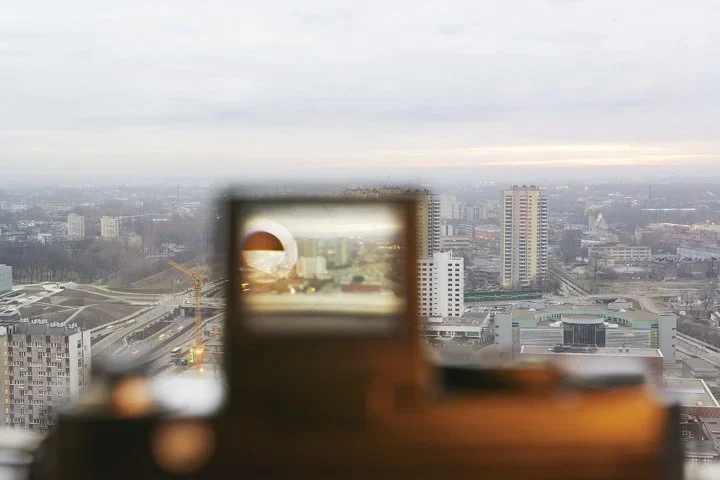EN / PT
PAOLO Rosselli’s Posing World: Photography After the Image
by Pedro Leão Neto
Paolo Rosselli’s exhibition Mondi in Posa at Triennale Milano, accompanied by his incisive essay Posing World, arrives at a moment when photography finds itself suspended between exhaustion and reinvention.
His large-format images, taken across global cities from the early 2000s to the present, capture not simply architecture, but the shifting atmospheres of metropolitan life in an age when, as Rosselli reminds us, perception has overtaken representation, and the city itself becomes a fused, vibrating field of signs.
Rosselli’s writing offers a rare interlacing of humour, critique, and philosophical unease. Many of his reflections speak directly to the challenges that contemporary photographers—and indeed all image-makers—face in a world saturated with digital accumulation.
Indeed, we cannot resist commenting on some noticeable and provocative passages in his essay, as when he writes, “Will photography’s re-entry into the realm of socially responsible art be a painless one?” This deceptively simple question underpins the entire text. For Rosselli, the difficulty lies in the fact that photography is increasingly detached from bodily experience and ethical encounter. When he discusses Doug Rickard’s practice—selecting Google Street View images taken by automated cameras—Rosselli situates the work within the American documentary lineage of Evans and Hopper, but also notes a crucial shift:
“The artist-photographer does not actually take the photos; instead, he works with images generated by automatic cameras at no specified time and according to no known criteria.”
In Rickard’s case, labour migrates from the field to the screen; authorship becomes an act of curation rather than capture. Rosselli does not condemn this; instead, he recognises it as an early—and honest—response to what Baudrillard foresaw as the “hegemony of the digital,” the moment when images proliferate beyond intention, beyond witnessing, beyond the human eye.
Rosselli writes with melancholy but also lucidity about the contemporary metropolis when he says that “People on the streets are the city… distinct subjects and entities that merge with advertising hoardings, colours, reflections in glass, automobiles.”
Here, Rosselli confronts photography’s anxiety: its “terror” before a world where historical depth and the “primeval” retreat from view. Metropolises, transformed by globalised aesthetics and homogenised experiences, resist the traditional role of photography as witness to local identity or rooted narratives. In this fusion, representation loses its authority:
“Representation… has been devalued: it no longer guarantees anything, because it no longer controls anything in the world.”
Towards the end of Posing World, Rosselli remarks on the surprising affinity between writing and photography:
“Two arts so different in nature and status communicate so well while remaining what they are.”
This “productive relationship” stems, he suggests, from their differences. Writing conjures images through language; photography consumes and circulates images at a rapid pace. In this reflection, Rosselli aligns himself with the Portuguese curator Delfim Sardo, who insists in many of his writings that photography gains depth when paired with conceptual thought: when images are not merely consumed but critically interpreted.
With Mondi in Posa, Paolo Rosselli offers something urgently needed today: not simply photographs of cities, but a conceptual framework for seeing them. His images revisit modernist icons, but with an ironic eye attuned to the contradictions of globalised urban culture. We believe that Rosselli’s work affirms photography’s continued relevance as a critical, reflective, and profoundly human practice within an increasingly algorithmic world, which aligns with many of the broader debates in contemporary visual studies.
It is also a privilege to acknowledge Paolo Rosselli’s longstanding presence within the Sophia Journal and scopio Editions community, as well as with research group Architecture, Art and Image (AAI) based at the Center for Studies in Architecture and Urbanism (CEAU) of Faculty of Architecture, University of Porto (FAUP). Over the years, we have had the honour of welcoming him as a guest in several Sophia Journal International Conferences and of publishing both his photographic work and his writings. Notably, A Talk on Architecture in Photography: Photographs by Paolo Rosselli—presented at the Venice Architecture Biennale—and his essay “Photography on Architecture: Visual Spaces of Change – Unveiling the Transformation of Publicness” (Sophia Journal, 2019) stand as important contributions that continue to resonate deeply within our ongoing reflections on architecture, image, and the contemporary city.
Triennale milano 2026
Exhibition Paolo Rosselli Mondi in posa
Curated by: Studio Paolo Rosselli In collaboration with: Francesco Paleari, Cecilia Da Pozzo, Giacomo Quinland Exhibition design: studio GISTO

